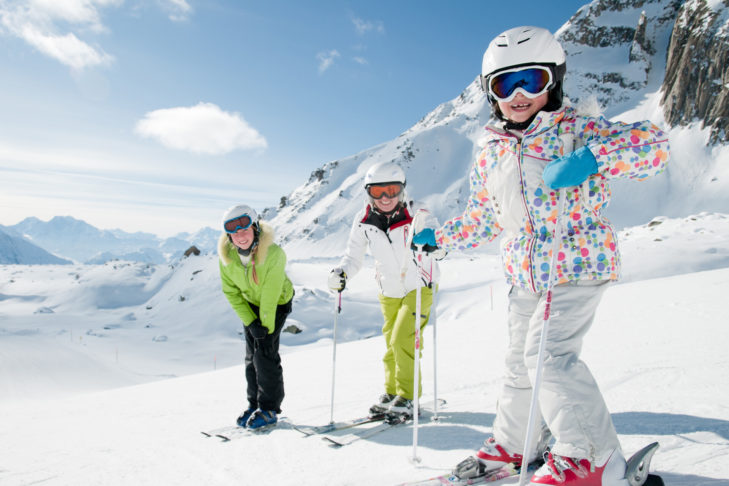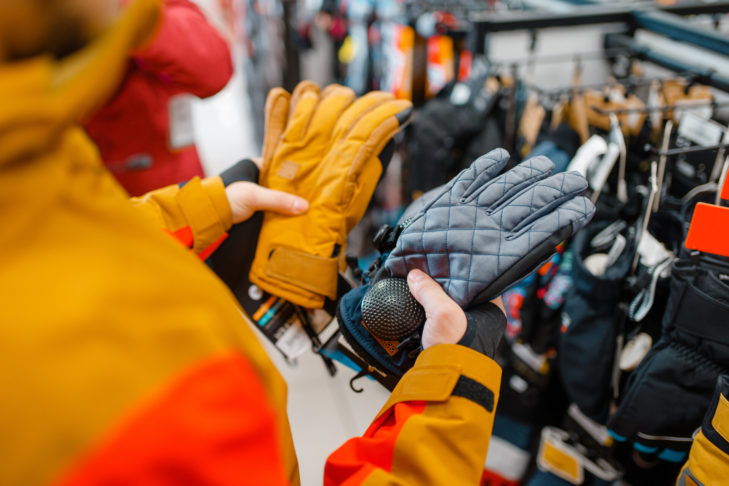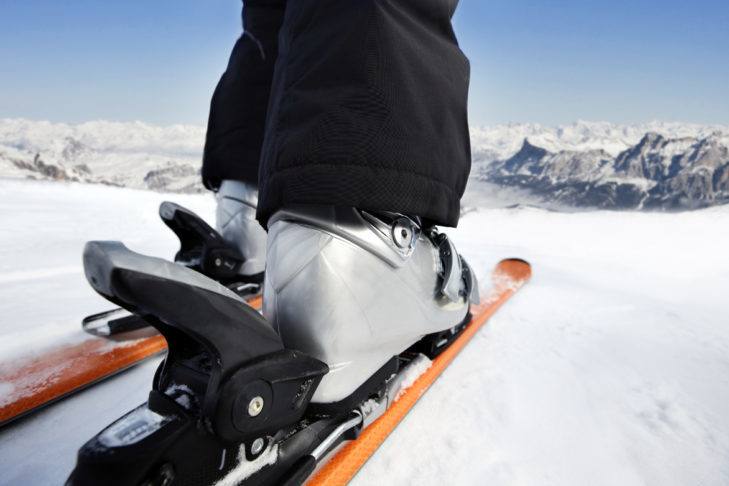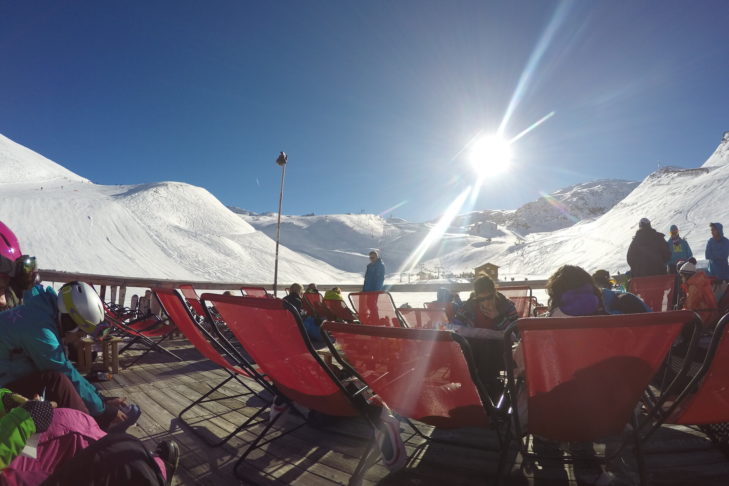Does it even make sense to learn skiing as a late starter, or do you have to have made your first turns in the snow already as a child? Not every beginning has to be difficult. It does not matter if you are a child or an adult – everybody can learn skiing or snowboarding and fully enjoy it even as a beginner. If you go on your first skiing holiday, good preparation and certain basic knowledge are essential. SnowTrex has 11 tips for ski beginners.
1. Choosing the right ski area
The fun factor of a skiing holiday has a significant relation to the choice of the ski area. Smaller, comprehensive ski areas are particularly suitable for beginners. Good choices for beginners are the German ski areas in the Bavarian Alps, in Winterberg, the Harz Mountains or in the Black Forest.
Especially in the beginning, an indoor ski hall can also be recommendable. If you are not dependant on holiday periods you should avoid the heavily frequented school holidays as well as the half term break.
2. Fitness makes getting started easier
A long day on skis can be quite exhausting. If you stay fit already before your skiing holiday, it is going to be a lot easier to start skiing or snowboarding. Strength, endurance and agility are a huge advantage. It also helps to prevent sore muscles, at least to some extent. Even though you have never been out and about in the snow, training throughout the whole year pays off! With the tips in our report “Fit for skiing” everybody will get into shape for the piste, beginners and experienced winter sports enthusiasts alike. A good way to prepare is, e.g. Nordic Walking, jogging, inline skating, skateboarding, cycling as well as ski gymnastics, strength training or yoga.
3. Should a beginner start off with skiing or snowboarding?
Many beginners ask themselves this question. For many, skiing is easier to learn, because you can move your legs independently of one another and because the bodily posture is more natural on skis than it is on a snowboard. However, if you already have experiences with sports like surfing or skating should have little difficulty getting started on a snowboard.
Either way: do not hesitate to try out both and see what suits you better. Snowboard beginners should keep in mind that getting into and out of the lift can be difficult in the beginning and needs practise.
4. Book ski lessons
If you a looking for a sense of achievement in skiing or snowboarding, it is recommendable to participate in a course. Here, trained teachers, who quickly recognise individual sources of error, take care of the beginners. A good ski school allows a maximum group size of 8 participants for children up to the age of six, and ten participants for beginners from the age of six. According to the German Ski Association (DSV), a sign of quality in Germany is the “Profi-Schule” (professional school) seal of approval. In France, you do not have to choose between different ski schools: The teachers of ESF (école du ski français) all have a state diploma.
5. The basics for skiing
If you want to try skiing on your own, you should definitely know the following: if you bring both of your skis next to each other, you go straight ahead. If you bring the skis together at the front, you go in the so-called snow-plough and get slower. A turn is made by shifting the weight from the mountain ski to the valley ski. The mountain ski is the one that stands above when you stand sideways to the slope. This means that the valley ski is the lower ski. Also important: Never lean too far back in your ski boots. This accelerates, and inexperienced skiers usually end up on their backside.
6. Clothes make people
The right winter sports clothing keeps you warm, dry and allows for enough freedom of movement. The materials should have a water column of at least 5,000 mm – the waterproofness of clothing is indicated as “water column” in millimetres. According to the European standard EN 343, a water column of 1,300 mm is considered waterproof. Layered clothing makes sense on the piste: in the warmer afternoon or after the first intense training, winter sports fans can take off a layer and prevent excessive sweating.
In addition to a ski suit, skis, poles and ski boots, ski equipment also includes a few more items. You should definitely buy ski underwear to keep your body warm. Depending on the temperature, you can also put on a (fleece) jumper over your ski vest. Ski socks should be worn on your feet and proper ski gloves on your hands. You should definitely wear a ski helmet on your head, which has the advantage that you don’t need a hat as well as being safer. Ideally, the ski helmet should fit perfectly with the ski goggles. If you want to protect yourself particularly well, you can also use a back protector. In any case, your equipment should include sun protection and a small first-aid kit. Dermatologists recommend a sun protection factor of at least 30.
By the way: Most people remember to wear their ski clothing and have their skis with them. The favourite thing to forget are the ‘accessories’. So check again just before you set off: Do you have your gloves, ski helmet and ski pass with you?
7. Renting equipment
Especially beginners or occasional skiers benefit from rental equipment. If you are not so enthusiastic about winter sports after all, you have not spent too much money on the purchase. The ski resorts usually have several sports shops where you can rent everything from snowboards to skis to boots and helmets. The advantages: individual advice, the latest technology and the possibility of quickly exchanging equipment. Make sure to plan for enough time for the selection of the right and, above all, comfortable equipment.
8. The set of rules
The 10 FIS Rules apply on the piste. Everybody should have them internalised. Accidents on the piste can be avoided by showing consideration for others. Every winter sports enthusiast should not only adapt their skiing style to their own ability, but also to weather conditions and traffic density, i.e. the number of persons on the piste.
9. Knowing the piste markings
In order to find your way in the ski area it makes sense to carry a piste map with you. Winter sports enthusiasts must know the piste markings: blue is for easy slopes, red for intermediate and black for difficult slopes. Beginners should use practise hills and wide, blue pistes for a start. Before you go on a piste it is essential that you have a good command of breaking.
10. Ideally, don’t embarrass yourself
If you don’t want to look like a complete beginner on the piste, you should bear the following in mind: Skis should be carried on the shoulder so that the ski tips are pointing downwards. On the lift, you should also keep a sufficient distance from the person in front of you and not run into their skis. There may also be nasty looks at the lift if you don’t fill it up and prefer to go on your own.
11. Take it easy
Especially beginners should not overstrain their bodies. Therefore: sleep in and start the day with some warm-up exercises. The first descents should be approached easily. Take a break regularly. Drink a lot, as your body loses more fluid in mountain air. In case of signs of fatigue, it is better to end the skiing day.
Conclusion
Despite all the rules, winter sports enthusiasts should not forget one thing: Skiing is fun! And with these tip for the right preparation, your introduction to skiing or snowboarding will definitely be a success, and possibly just one of many.
Extra: our Trexpert’s Felix Neureuther’s tip for beginners
“Beginners should definitely take a ski instructor to learn the basic positions correctly. Most skiers are usually too upright and have too much supine position on their skis. With a professional ski instructor you will avoid misalignments that are difficult to correct later. This is especially true for children.”
FAQs for beginners
Can you still learn to ski as an adult?
Anyone can learn to ski as long as there is no medical reason not to.
Which ski areas are suitable for beginners?
Beginners should make their first turns in small, manageable ski areas or choose ski areas with lots of blue pistes.
What can make it easier to start skiing?
Skiing requires strength, stamina and agility, so people who keep fit before their first skiing holiday will have a more relaxed start to skiing.
Do you have to attend a ski course as a beginner?
Of course it is not compulsory, but it is highly recommended that beginners attend a ski course and learn from professionals. Success is guaranteed with trained ski instructors.
Should beginners buy their own equipment?
Beginner skiers in particular benefit from hire equipment, because: If the enthusiasm for the sport is not too great at the end of the skiing holiday after all, you haven’t spent much money on your own equipment. It’s therefore better not to buy your own equipment until you’re convinced you can ski!
What is the most common mistake made by beginner skiers?
Novice skiers often have too much of a supine position. This is done intuitively in order to slow down, but has exactly the opposite effect: you speed up and, in the worst case, fall down.









